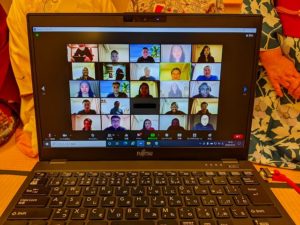Date and Time: Monday, December 14, 6:30 p.m. – 7:30 p.m.
Spot: Japanese-style room in Japan International Cooperation Agency (JICA) Yokohama office
Participants: 34 JICA Participants from Mongolia, Middle East, and Africa
Attendants: 4 KSGG members
Language: English
KSGG members lectured on the Japanese tea ceremony as a series of seminars on introduction to Japanese cultures held by JICA Yokohama following the previous months of October and November. As many as 34 participants joined the tea ceremony demonstrated by the KSGG lecturers through Zoom call sitting in their own rooms in order to prevent the Novel Coronavirus from spreading this time, too. They asked the KSGG members some questions with interest after the tea ceremony presentation. The Zoom tea ceremony was the last seminar of this year and turned so much successful with a lot of participants and questions from them.
As some questions were difficult to hear online, the participants and KSGG members also exchanged text messages via the group chat in Zoom. The members were pleased to take a lot of questions from them like that, “Do you enjoy tea-ceremony at home?”, “Do I need practice to join a tea ceremony?”, “Do men also enjoy it?”, “Why do you exchange greetings without saying anything?”, “Do you understand each other?”, and so on. The members answered their questions bearing in mind the four most important elements of the tea ceremony: harmony, respect, purity, and tranquility. The lecturers tried to deepen their understanding of the tea-ceremony, which has been deeply influenced by the spirit of the Zen Buddhism. The participants asked the members about Kimono as well. One of the participants said that they had traditional clothes like Japanese Kimonos in their country.
Due to the current situation with coronavirus spreading, the members wore facemasks. And the members prepared individually wrapped-sweets for the participants although unpacked Japanese sweets were usually used with Japanese tea. It was regrettable that the members couldn’t give the participants a demonstration in an original way. But all of the members wore Japanese Kimonos to have the participants, who came long way from their countries, experience the traditional Japanese culture even a little bit. Most of the participants were university students. The members really hoped that they could take in-person classes at university instead of online classes.

